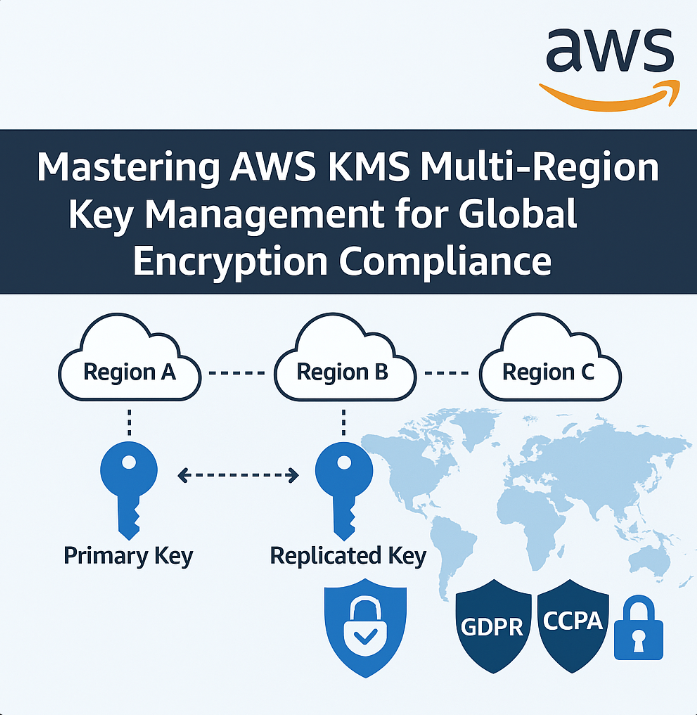
In a world where data privacy regulations are increasing in scope and complexity—GDPR in Europe, PDPA in Southeast Asia, CCPA in the US—cloud-native organizations must be more deliberate than ever with how they manage data encryption.
Encryption is no longer a performance option—it’s a compliance mandate. And for global applications, this means building encryption strategies that not only secure data, but also align with regional data sovereignty laws.
AWS Key Management Service (KMS) provides a scalable and compliant way to create, manage, and use encryption keys. In this guide, we’ll focus on multi-region key management, a feature that helps you protect data while reducing latency and simplifying compliance across jurisdictions.
Why Multi-Region KMS Matters for Compliance
Here’s why multi-region key strategies are now essential for global businesses:
Regulatory requirements: Laws like GDPR often mandate that encrypted data and keys reside within a particular region.
Business continuity: For disaster recovery, replicating keys across regions allows seamless decryption in failover scenarios.
Operational simplicity: Instead of managing dozens of separate keys, multi-region keys provide a single logical key with distributed instances.
Latency reduction: Locally available keys avoid inter-region network calls during encryption or decryption.
How AWS KMS Multi-Region Keys Work
Multi-region keys in AWS KMS are cryptographically equivalent keys in different AWS regions that are logically linked:
You create a primary key in one region.
You can replicate that key to any other supported region.
Each key replica maintains the same key material and usage policies.
Updates to policies, key rotation, and tags can be propagated across all replicas.
Note: Key usage (Encrypt/Decrypt) is local to each region; key material does not cross regions during operations.
Multi-Region Key Setup: Step-by-Step Guide
Step 1: Create the Primary Multi-Region Key
aws kms create-key \ --description "Global App Encryption Key" \ --multi-region \ --key-usage ENCRYPT_DECRYPT
Step 2: Replicate the Key to Other Regions
aws kms replicate-key \ --key-id <primary-key-id> \ --replica-region us-west-2
Step 3: Use the Key in Application Code
Use the keyId or alias in the region-local context where your application is running.
Example (Python Boto3):
kms = boto3.client('kms', region_name='us-west-2')
response = kms.encrypt(KeyId='alias/global-key', Plaintext=b'my data')Step 4: Manage Access and Policies
Define IAM key policies that apply across all replicas
Enable automatic key rotation for security best practices
Audit with CloudTrail for compliance reporting
Compliance Benefits of Multi-Region Key Strategy
| Compliance Goal | How Multi-Region KMS Helps |
|---|---|
| Data locality | Keeps encrypted data and keys in-region for GDPR, PDPA, HIPAA |
| Disaster recovery | Enables rapid failover with regional key replicas |
| Central governance | Unified key policy and tagging strategy across regions |
| Auditability | CloudTrail logs show access per region, key, and user |
| Key isolation | Avoids shared keys across conflicting jurisdictions |
Best Practices for Multi-Region Key Management
Use aliases for logical key mapping to simplify application logic.
Enable automatic rotation to reduce cryptographic risk.
Integrate with services like S3, EBS, RDS, Lambda for seamless at-rest encryption.
Monitor key usage patterns using CloudWatch Metrics and AWS Config.
Set up CloudTrail alerts for unauthorized access or cross-region anomalies.
When Not to Use Multi-Region Keys
Multi-region KMS is powerful—but not always necessary. Here’s when single-region keys are preferable:
If you operate only within a single jurisdiction with strict local data laws (e.g., China Mainland)
When you need to guarantee key separation per client or tenant for multi-tenancy
When using custom key stores (CloudHSM), which are not supported in multi-region mode
CloudFlew Services for Global Encryption Compliance
At CloudFlew, we help companies navigate cloud compliance challenges with:
Multi-region encryption architecture design
KMS key lifecycle management workflows
Key policy auditing and rotation automation
Real-time compliance dashboards for key access
Alignment with ISO 27001, SOC2, GDPR, HIPAA requirements
Final Thoughts
Encryption isn’t just a security feature—it’s a regulatory necessity. With AWS KMS multi-region key management, your organization can:
Encrypt global workloads securely
Stay compliant across borders
Improve application performance
Simplify key lifecycle management
CloudFlew can help you design and deploy a cloud-native key strategy that’s not just secure—but globally ready.

